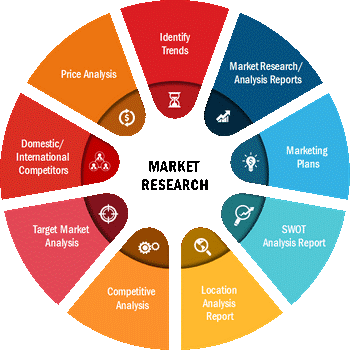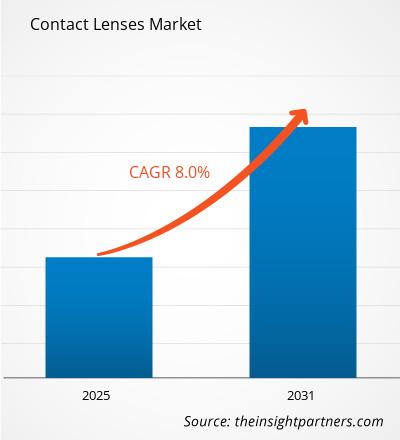2021 年隐形眼镜市场估值为 9.22 亿美元,并且很可能到 2031 年达到 130.5 亿美元,2022 年至 2031 年复合年增长率为 5.1%。
隐形眼镜是一种薄而弯曲的镜片,放置在覆盖人眼表面的泪膜上。一般来说,镜片是自然透明的,但有时会带有轻微的色调,以便佩戴者更容易操作。
现代隐形眼镜要么是软的,要么是硬的。然而,现在人们更喜欢佩戴软性隐形眼镜,因为其具有柔韧性。
市场动态
隐形眼镜市场的特点是存在各种大大小小的公司。市场参与者正在采取各种策略来增加市场份额,例如新产品推出、区域扩张和技术进步。近视和近视患病率不断上升其他视觉障碍、改善审美的趋势不断上升以及可支配收入的增加鼓励市场参与者推出新产品。
不断增加的产品推出和开发推动了隐形眼镜的采用。市场参与者正在投资研发以开发先进技术,并通过获得监管批准和营销准入来获得更多收入份额。
市场范围
《到2031年全球隐形眼镜市场分析》是对市场的专业和深入研究,特别注重全球市场趋势分析。该报告旨在概述隐形眼镜市场,并按材料、设计、应用和分销渠道进行详细的市场细分。
全球隐形眼镜市场预计在预测期内将出现高速增长。该报告提供了有关主要市场参与者状况的关键统计数据,并提供了市场的主要趋势和机会。
战略见解
市场细分
全球隐形眼镜市场根据材料、设计、应用和分销渠道进行细分。根据材料,市场分为透气性、硅胶水凝胶和其他的。根据设计,市场分为单视、球面、多焦点和复曲面。根据应用,市场分为矫正、治疗、美容等。此外,市场根据分销渠道细分为电子商务、医院、诊所和零售店。
该报告提供了详细的行业概述,包括定性和定量信息。它提供了基于各个细分市场的全球隐形眼镜市场的概述和预测。它还提供了2022年至2031年5个主要地区的市场规模和预测估计:北美、欧洲、亚太地区(APAC)、中东和非洲(MEA)以及南美洲和中美洲。每个地区的隐形眼镜市场随后按各自的国家和细分市场进行细分。该报告涵盖了对全球 18 个国家以及该地区当前趋势和机遇的分析和预测。
从区域角度来看,北美在隐形眼镜市场上占据主导地位。该地区的主导地位主要归因于受视力障碍影响的患者数量不断增加以及市场参与者对战略合作和伙伴关系的高度关注。
此外,媒体和娱乐等各个行业都在大量使用美容镜片,导致北美美容镜片的采用率增加,并推动了整个区域市场的发展.
下图展示了全球隐形眼镜的收入增长趋势市场:
< span style="font-family: verdana, Geneva, sans-serif; font-size: 10pt;">来源:Insight Partners 分析
报告从需求端和供给端分析影响隐形眼镜市场的因素,并进一步评估市场动态,即驱动因素、限制因素、机会和未来趋势,在预测期内。该报告还提供了 PEST 分析,重点介绍了影响这些地区隐形眼镜市场的因素。
COVID-19 大流行的影响
COVID-19 的爆发反映了全球隐形眼镜需求的下降。这一流行病对各个行业和部门产生了相当大的社会和经济影响。就隐形眼镜而言,由于眼部护理咨询有限,市场出现下滑。
此外,博士伦、库珀公司和强生等主要市场参与者均报告称,由于销售额和销售量下降,销售额出现下降。运营。这导致知名公司和新兴公司改变其业务战略以适应。因此,COVID-19的影响在一定程度上阻碍了全球隐形眼镜市场。
市场参与者
报告涵盖隐形眼镜市场有机和无机增长战略的关键发展。许多公司都专注于有机增长战略,例如产品发布、产品批准以及专利和活动。市场上见证的无机增长战略活动包括收购、合作和收购。合作。这些活动为业务扩展和市场参与者的客户群铺平了道路。随着隐形眼镜需求的不断增长,预计市场参与者将获得利润丰厚的增长机会。
该报告还包括主要隐形眼镜市场公司的概况、SWOT 分析和市场策略。此外,该报告还重点介绍了领先的行业参与者,提供了公司简介、所提供的组件和服务、过去三年的财务信息以及过去五年的主要发展等信息。
EssilorLuxottica;爱尔康公司;强生公司约翰逊服务公司;博士士隆姆公司;库珀公司;霍亚公司; SynergEyes 公司; STAAR 外科公司; X-Cel 专业触点;和 Medenniumare 是研究中介绍的主要市场参与者。本研究还对其他几家主要公司进行了研究和分析,以全面了解隐形眼镜市场及其生态系统。
Insight Partner 的专业研究和分析团队由经验丰富的专业人士组成,拥有先进的统计专业知识,并在当前研究中提供各种定制选项。
< br>
- 历史分析(2 年)、基准年、预测(7 年)及复合年增长率
- PEST 和 SWOT 分析
- 市场规模价值/数量 - 全球、区域、国家
- 行业和竞争格局
- Excel 数据集



Report Coverage
Revenue forecast, Company Analysis, Industry landscape, Growth factors, and Trends

Segment Covered
This text is related
to segments covered.

Regional Scope
North America, Europe, Asia Pacific, Middle East & Africa, South & Central America

Country Scope
This text is related
to country scope.
常见问题
The contact lenses market is estimated to grow with a CAGR of 6% from 2023 to 2031.
Asia Pacific region is likely to witness fastest growth rate during the forecast period.
The market drivers include growing prevalence of myopia and advancements in technology are driving the contact lenses market
The contact lenses market majorly consists of the players such as EssilorLuxottica, Alcon Inc., Johnson & Johnson Services, Inc among others.
Orthokeratology (OK) and hybrid lenses are likely to remain the key trend during the forecast period
North America dominated the contact lenses market in 2023
Trends and growth analysis reports related to Life Sciences : READ MORE..
The List of Companies
1. Bausch & Lomb Incorporated.
2. Carl Zeiss Meditec AG
3. Johnson & Johnson Services, Inc.
4. Alcon (Novartis International AG)
5. HOYA Corporation
6. The Cooper Companies Inc.
7. BenQ Materials Corporation
8. Essilor
9. Contamac
10. SynergEyes, Inc.
11. NIDEK CO., LTD.
12. NJRetina
13. OcuMedic
14. Interojo
15. Seed Co., Ltd.
The Insight Partners performs research in 4 major stages: Data Collection & Secondary Research, Primary Research, Data Analysis and Data Triangulation & Final Review.
- Data Collection and Secondary Research:
As a market research and consulting firm operating from a decade, we have published and advised several client across the globe. First step for any study will start with an assessment of currently available data and insights from existing reports. Further, historical and current market information is collected from Investor Presentations, Annual Reports, SEC Filings, etc., and other information related to company’s performance and market positioning are gathered from Paid Databases (Factiva, Hoovers, and Reuters) and various other publications available in public domain.
Several associations trade associates, technical forums, institutes, societies and organization are accessed to gain technical as well as market related insights through their publications such as research papers, blogs and press releases related to the studies are referred to get cues about the market. Further, white papers, journals, magazines, and other news articles published in last 3 years are scrutinized and analyzed to understand the current market trends.
- Primary Research:
The primarily interview analysis comprise of data obtained from industry participants interview and answers to survey questions gathered by in-house primary team.
For primary research, interviews are conducted with industry experts/CEOs/Marketing Managers/VPs/Subject Matter Experts from both demand and supply side to get a 360-degree view of the market. The primary team conducts several interviews based on the complexity of the markets to understand the various market trends and dynamics which makes research more credible and precise.
A typical research interview fulfils the following functions:
- Provides first-hand information on the market size, market trends, growth trends, competitive landscape, and outlook
- Validates and strengthens in-house secondary research findings
- Develops the analysis team’s expertise and market understanding
Primary research involves email interactions and telephone interviews for each market, category, segment, and sub-segment across geographies. The participants who typically take part in such a process include, but are not limited to:
- Industry participants: VPs, business development managers, market intelligence managers and national sales managers
- Outside experts: Valuation experts, research analysts and key opinion leaders specializing in the electronics and semiconductor industry.
Below is the breakup of our primary respondents by company, designation, and region:

Once we receive the confirmation from primary research sources or primary respondents, we finalize the base year market estimation and forecast the data as per the macroeconomic and microeconomic factors assessed during data collection.
- Data Analysis:
Once data is validated through both secondary as well as primary respondents, we finalize the market estimations by hypothesis formulation and factor analysis at regional and country level.
- Macro-Economic Factor Analysis:
We analyse macroeconomic indicators such the gross domestic product (GDP), increase in the demand for goods and services across industries, technological advancement, regional economic growth, governmental policies, the influence of COVID-19, PEST analysis, and other aspects. This analysis aids in setting benchmarks for various nations/regions and approximating market splits. Additionally, the general trend of the aforementioned components aid in determining the market's development possibilities.
- Country Level Data:
Various factors that are especially aligned to the country are taken into account to determine the market size for a certain area and country, including the presence of vendors, such as headquarters and offices, the country's GDP, demand patterns, and industry growth. To comprehend the market dynamics for the nation, a number of growth variables, inhibitors, application areas, and current market trends are researched. The aforementioned elements aid in determining the country's overall market's growth potential.
- Company Profile:
The “Table of Contents” is formulated by listing and analyzing more than 25 - 30 companies operating in the market ecosystem across geographies. However, we profile only 10 companies as a standard practice in our syndicate reports. These 10 companies comprise leading, emerging, and regional players. Nonetheless, our analysis is not restricted to the 10 listed companies, we also analyze other companies present in the market to develop a holistic view and understand the prevailing trends. The “Company Profiles” section in the report covers key facts, business description, products & services, financial information, SWOT analysis, and key developments. The financial information presented is extracted from the annual reports and official documents of the publicly listed companies. Upon collecting the information for the sections of respective companies, we verify them via various primary sources and then compile the data in respective company profiles. The company level information helps us in deriving the base number as well as in forecasting the market size.
- Developing Base Number:
Aggregation of sales statistics (2020-2022) and macro-economic factor, and other secondary and primary research insights are utilized to arrive at base number and related market shares for 2022. The data gaps are identified in this step and relevant market data is analyzed, collected from paid primary interviews or databases. On finalizing the base year market size, forecasts are developed on the basis of macro-economic, industry and market growth factors and company level analysis.
- Data Triangulation and Final Review:
The market findings and base year market size calculations are validated from supply as well as demand side. Demand side validations are based on macro-economic factor analysis and benchmarks for respective regions and countries. In case of supply side validations, revenues of major companies are estimated (in case not available) based on industry benchmark, approximate number of employees, product portfolio, and primary interviews revenues are gathered. Further revenue from target product/service segment is assessed to avoid overshooting of market statistics. In case of heavy deviations between supply and demand side values, all thes steps are repeated to achieve synchronization.
We follow an iterative model, wherein we share our research findings with Subject Matter Experts (SME’s) and Key Opinion Leaders (KOLs) until consensus view of the market is not formulated – this model negates any drastic deviation in the opinions of experts. Only validated and universally acceptable research findings are quoted in our reports.
We have important check points that we use to validate our research findings – which we call – data triangulation, where we validate the information, we generate from secondary sources with primary interviews and then we re-validate with our internal data bases and Subject matter experts. This comprehensive model enables us to deliver high quality, reliable data in shortest possible time.

 获取此报告的免费样本
获取此报告的免费样本